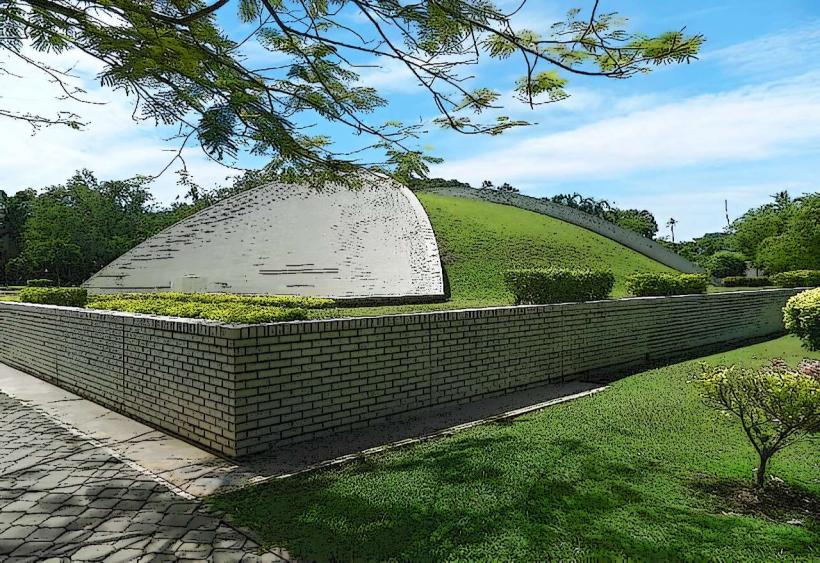Information
Landmark: Labuan Marine MuseumCity: Labuan
Country: Malaysia
Continent: Asia
The Labuan Marine Museum is an important cultural and educational institution located on Labuan Island, Malaysia. It provides visitors with insights into the region's rich maritime history, marine biodiversity, and the vital role that the sea has played in the lives of the people of Labuan and the surrounding areas.
Key Features and Highlights of Labuan Marine Museum
Historical Significance:
- The Labuan Marine Museum focuses on the maritime heritage of the island and its role in the maritime trade routes of the region. Labuan’s strategic location in the South China Sea has made it an important port and trading hub throughout history, particularly during the colonial period and World War II.
- The museum offers a deeper understanding of the island’s historical connections with the sea, including its role during the Japanese occupation in World War II and its post-war recovery as a key shipping and oil industry center.
Location:
- The museum is located in the town of Victoria, the main town of Labuan Island. It is situated near the waterfront, offering convenient access to both the museum and the scenic views of the surrounding marine environment.
- Its location reflects the museum’s connection to Labuan’s maritime history, which revolves around its proximity to important shipping lanes and coastal trade routes.
Exhibits and Displays: The Labuan Marine Museum features a diverse range of exhibits that are divided into several thematic sections:
- Maritime Trade: This section explores the importance of Labuan as a port of call for trade between Southeast Asia and the rest of the world. The exhibits highlight historical shipping routes, ancient trade practices, and Labuan’s role in the international maritime industry.
- Shipwrecks and Maritime Archaeology: The museum also showcases maritime archaeology, including displays of shipwrecks found in the waters around Labuan and the significance of these artifacts in understanding the region’s historical maritime activities.
- Marine Biodiversity: One of the museum's key sections is dedicated to the marine life surrounding Labuan Island. The exhibits include a variety of marine species, such as coral reefs, fish, and sea turtles, as well as the conservation efforts being undertaken to preserve these ecosystems. Labuan’s waters are home to a diverse range of marine life, and the museum sheds light on their ecological importance.
- Fishing Industry: The fishing industry plays a significant role in the livelihoods of the people of Labuan, and the museum offers an in-depth look at the historical and modern practices in local fishing, the tools used, and how fishing activities contribute to Labuan’s economy.
- World War II Exhibits: Given Labuan's role in World War II, the museum also features exhibits on the island’s strategic importance during the war, including the military uses of its ports and the battles that took place in the region.
- Traditional Maritime Practices: This section highlights the traditional boat-building techniques and seafaring culture of the indigenous people and coastal communities around Labuan.
Educational Role:
- The Labuan Marine Museum plays an important educational role in raising awareness about the importance of the sea and maritime heritage. It educates visitors about the marine conservation efforts in the region and the need to protect the marine environment from pollution and over-exploitation.
- It also serves as a resource for those interested in the history of the South China Sea, the significance of Labuan Island, and the broader maritime heritage of Malaysia.
Visitor Experience:
- The museum offers a comprehensive visitor experience with informative signage and displays that are accessible to both locals and tourists. Interactive exhibits allow visitors to engage with the content and gain a better understanding of the topics.
- The museum is also equipped with educational materials such as audio-visual presentations, guided tours, and occasional workshops or events that delve deeper into marine conservation and maritime history.
Research and Conservation:
- The museum is involved in marine research and works with local institutions to study the marine ecosystem around Labuan. It also highlights efforts to protect the island's unique underwater ecosystems, including coral reefs and seagrass beds.
- The museum is part of a wider initiative to promote eco-tourism in Labuan, and visitors are encouraged to learn about the importance of sustainable practices to ensure the preservation of marine environments.
Opening Hours and Admission:
- The Labuan Marine Museum is generally open to visitors throughout the week, with specific opening hours. Admission is typically affordable, and there may be discounts for students, children, and senior citizens.
- As the museum is located in a tourist-friendly area, it is often combined with other cultural and heritage sites in Labuan as part of a broader sightseeing tour.
Labuan’s Marine Environment:
- The museum also highlights Labuan’s role in marine tourism, with visitors often exploring nearby diving sites, snorkeling, and beach activities after learning about the island’s marine heritage. The island's surrounding waters are known for their clear waters, rich marine life, and excellent diving conditions, making it a popular destination for eco-tourists.
Conclusion
The Labuan Marine Museum is an enriching destination for anyone interested in Labuan’s maritime heritage, marine biodiversity, and history. Whether you are a history enthusiast, a marine conservation advocate, or simply a visitor looking to learn more about Labuan’s cultural background, the museum offers an insightful and educational experience. It provides a deeper understanding of the island’s role in the maritime industry, the global economy, and its unique marine environment, which continues to be a vital part of Labuan’s identity.



